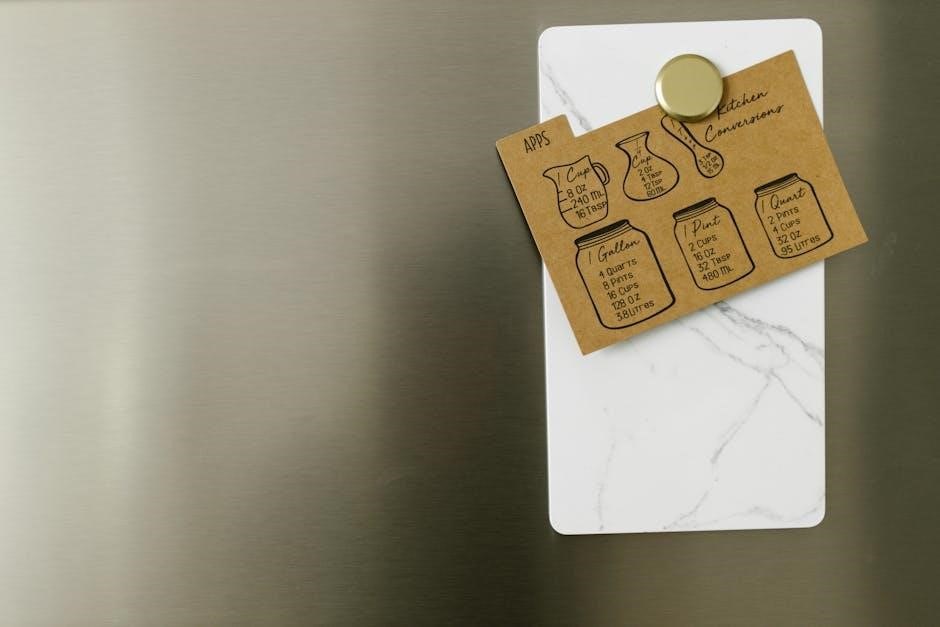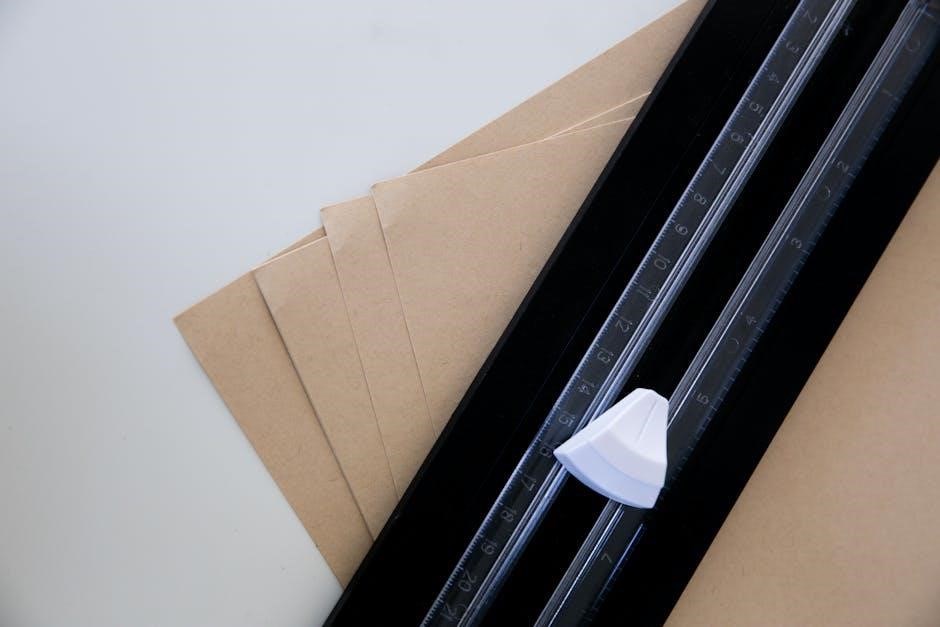A stoma measuring guide is a tool used to determine the size of a stoma, ensuring proper fit for ostomy appliances․ It helps maintain skin health and appliance functionality․
1․1 Definition of a Stoma
A stoma is an artificial opening surgically created on the abdomen to divert the flow of waste from the digestive or urinary system to an external pouch․ It is typically round or oval in shape and connects the bowel to the skin surface․ The stoma itself is not sensitive, as it lacks nerve endings, and its appearance may vary depending on the type of surgery and individual anatomy․ Proper care and measurement of the stoma are crucial for maintaining skin health and ensuring the correct fit of ostomy appliances․ A stoma measuring guide is essential for accurately determining its size, which is vital for selecting the right products and preventing complications․ Understanding the stoma’s structure and function is the first step in effective management and care․
1․2 Purpose of a Stoma Measuring Guide
The primary purpose of a stoma measuring guide is to accurately determine the size and shape of a stoma, ensuring the best fit for ostomy appliances․ Proper measurement is crucial for preventing complications such as skin irritation, leakage, and poor adhesion of the pouching system․ The guide provides a series of precut circles or ovals, allowing users to match their stoma’s dimensions precisely․ This tool is essential for both new ostomy patients and experienced users, as stomas can change in size over time due to factors like weight fluctuations or healing processes․ Using a measuring guide helps in selecting the correct size of skin barriers and pouches, promoting comfort, confidence, and optimal wound healing․ Regular use of the guide ensures consistent and reliable measurements, which are vital for maintaining a healthy and active lifestyle with an ostomy․

Importance of Accurate Stoma Measurement
Accurate stoma measurement is vital to prevent complications like leakage, skin irritation, and poor appliance fit․ Proper sizing ensures comfort, functionality, and optimal pouching system performance, enhancing overall quality of life․
2․1 Consequences of Incorrect Measurement
Incorrect stoma measurement can lead to skin irritation, leakage, and poor fit of ostomy appliances․ This may result in discomfort, reduced wear time, and increased risk of peristomal skin complications․ Additionally, improper sizing can cause frequent appliance changes, higher product usage, and increased healthcare costs․ In severe cases, persistent issues may necessitate medical intervention or adjustments to the stoma itself․ Ensuring accurate measurements is crucial to prevent these complications and maintain optimal skin health and appliance functionality․ Regular monitoring and timely adjustments are essential to address any changes in stoma size or shape․ Proper fit not only enhances comfort but also promotes confidence and independence for individuals with ostomies․ Accurate measurement is the foundation of effective stoma care, directly impacting quality of life and overall well-being․
2․2 Benefits of Proper Fit
A proper fit ensures optimal comfort and prevents skin irritation, reducing the risk of complications․ It extends the wear time of ostomy appliances, minimizing frequent changes․ Proper sizing enhances confidence, allowing individuals to engage in daily activities without discomfort or leaks․ It also promotes better adhesion, reducing the need for additional products․ Accurate measurement ensures the appliance moves with the body, preventing restrictions․ Proper fit is essential for maintaining skin integrity and overall health․ It allows individuals to live comfortably and confidently with their ostomy․ By prioritizing proper fit, users can enjoy a better quality of life․ Regular monitoring and accurate measurement are key to achieving these benefits․ Proper fit is the cornerstone of effective stoma care, enhancing both physical and emotional well-being․ It ensures a seamless integration of the appliance into daily life․

Tools Required for Stoma Measurement
Circular measuring rulers, oval guides, and measuring strips are essential tools for accurate stoma sizing, ensuring proper fit and preventing complications․ These tools help determine the correct appliance size․
3․1 Circular Measuring Rulers
Circular measuring rulers are specifically designed to measure round stomas, providing accurate diameter readings․ They feature pre-marked sizes, making it easy to match the stoma’s size to the appropriate ostomy appliance․ Proper use ensures a snug fit, preventing leaks and skin irritation․ Regularly checking the ruler’s calibration ensures accuracy․ Always use the ruler provided with your ostomy products for consistency․ For oval stomas, while circular rulers are less common, they can still be used in conjunction with other tools for precise measurements․ This dual functionality makes them versatile for various stoma types․ Proper measurement is crucial for maintaining skin health and appliance functionality, ensuring comfort and confidence for individuals with stomas․ Accurate sizing also helps prevent complications, making circular rulers an indispensable tool in stoma care․ Regular monitoring and documentation of measurements are recommended to track changes and adjust as needed․ Using the correct tools and techniques ensures optimal outcomes for stoma patients․ Proper hygiene practices should be followed when handling measuring tools to prevent contamination and maintain a sterile environment․ Training and guidance from healthcare professionals can significantly improve measurement accuracy and overall stoma management․ Staying informed about the latest tools and techniques is essential for effective stoma care․ Always refer to the manufacturer’s guidelines for the specific measuring ruler being used to ensure compliance and safety․ By adhering to these practices, individuals can manage their stoma effectively and maintain a high quality of life․
3․2 Oval Measuring Guides
Oval measuring guides are specialized tools designed for accurately measuring oval-shaped stomas․ They feature pre-marked scales to determine both the length and width of the stoma, ensuring a precise fit for ostomy appliances․ Unlike circular rulers, oval guides account for the two-dimensional nature of oval stomas, providing a more tailored measurement․ Proper use involves aligning the guide with the stoma’s edges to identify the closest matching size․ This helps prevent complications such as skin irritation or poor appliance adhesion․ Regularly verifying the guide’s accuracy ensures reliable results․ For individuals with oval stomas, these tools are essential for maintaining comfort and preventing leaks․ Always use the guide provided with your ostomy products for consistency․ If unsure, consult a healthcare professional for proper measurement techniques․ Accurate sizing is key to optimal stoma care and overall well-being․
3․3 Measuring Strips
Measuring strips are flexible tools used to measure both round and oval stomas accurately․ They feature graduated markings to determine the diameter of round stomas or the length and width of oval stomas․ To use, gently align the strip with the stoma’s edge, ensuring it lies flat against the skin․ This provides precise measurements to select the correct size of ostomy appliances․ Measuring strips are particularly useful for irregularly shaped stomas, as they can conform to the stoma’s contours․ Regular use helps maintain proper fit and prevents complications like skin irritation or leakage․ For best results, use the strip in conjunction with other measuring tools and ensure the stoma is at its typical size during measurement․ Measuring strips are portable and easy to use, making them a practical addition to stoma care routines․ Always store them in a clean, dry place to maintain accuracy and hygiene․

Preparation for Measuring
Proper preparation ensures accurate stoma measurement․ Maintain hygiene, choose the right time, and set up a comfortable environment․ This helps in obtaining precise measurements for the best appliance fit․
4․1 Hygiene Practices
Ensuring proper hygiene is crucial before measuring a stoma․ Wash your hands thoroughly with soap and water․ Clean the stoma and surrounding skin with a gentle, non-irritating cleanser to remove any residue or bacteria․ Avoid using harsh chemicals or abrasive materials that could irritate the skin․ Pat the area dry with a clean towel to prevent moisture from interfering with the measurement process․ A clean environment reduces the risk of infection and ensures accurate measurements․ Additionally, disinfect the measuring tools before use to maintain sterility․ Proper hygiene practices not only protect the patient but also contribute to the reliability of the measurement results․ By following these steps, you create a safe and hygienic condition for stoma measurement․
4․2 Timing of Measurement
The timing of stoma measurement is critical for accuracy․ Measure the stoma when it is at rest to avoid distortion from muscle tension or gas; Typically, this occurs in the morning before eating or drinking, as the stoma is less active․ Avoid measuring immediately after a bowel movement or when the stoma is protruding, as this can lead to incorrect sizing․ Consistency in timing ensures reliable measurements over time․ If the stoma is irregularly shaped or prone to fluctuations, consider measuring at the same time each day․ Proper timing helps in obtaining a true representation of the stoma’s size, which is essential for fitting ostomy appliances correctly․ Always follow a consistent routine to maintain measurement accuracy and reliability․
4․3 Environment Setup
Setting up the right environment is crucial for accurate stoma measurement․ Ensure the area is clean, well-lit, and free from distractions․ A comfortable and private space helps the individual relax, making the process easier․ Position the stoma at a comfortable height to avoid strain․ Use a mirror if necessary to improve visibility, especially for individuals with limited dexterity․ Gather all measurement tools beforehand to avoid interruptions․ The stoma should be exposed and free of any covering or residue․ Maintain a neutral body position to prevent stretching or compressing the stoma, which could lead to inaccurate measurements․ A calm and prepared environment ensures consistency and precision in the measurement process, contributing to better outcomes for stoma care and appliance fitting․

Measuring Round Stomas
Round stomas are measured using circular rulers, focusing on the diameter․ Ensure accurate sizing for proper appliance fit and skin protection․ Consistency is key for optimal stoma care․
5․1 Step-by-Step Process
To measure a round stoma, start by gently placing the circular measuring guide over the stoma, ensuring the center hole aligns with the stoma’s center․ Adjust the guide until it fits snugly around the stoma without causing irritation․ The edges of the guide should touch the skin evenly․ Once properly aligned, identify the size by matching the stoma’s diameter to the pre-cut circles on the guide․ Document the measurement for accurate appliance sizing․ Repeat the process periodically to account for any size changes․ For best results, measure when the stoma is at rest and avoid pressing too firmly, which could distort the shape․ Using a mirror may help improve visibility․ Consistent and precise measurements are essential for optimal fit and skin health․
5․2 Interpreting Diameter Measurements
Interpreting diameter measurements for round stomas involves matching the stoma’s size to the appropriate appliance․ After obtaining the diameter using the circular guide, compare it to the sizes available in ostomy products․ The diameter should align closely with the pre-cut skin barrier to ensure a secure fit․ If the stoma measures between two sizes, consider the next larger size to accommodate slight variations․ Proper interpretation prevents issues like leakage or skin irritation․ Regular monitoring is crucial, as stomas can change in size due to factors like weight fluctuation or scar contraction․ Always refer to the product’s sizing chart for compatibility and consult a healthcare professional if unsure․ Accurate interpretation ensures optimal comfort, functionality, and skin integrity, promoting overall well-being for individuals with a stoma․

Measuring Oval Stomas
Oval stoma measurement involves assessing both the length and width․ Using oval guides, match the stoma’s dimensions to ensure accurate fitting of the ostomy appliance, preventing complications․
6․1 Step-by-Step Process
To measure an oval stoma accurately, begin by gently cleaning the area around the stoma with mild soap and water to ensure visibility․ Place the oval measuring guide over the stoma, aligning it with the center․ Carefully match the stoma’s edges to the guide’s markings, noting the longest length and widest width․ Ensure the guide is flat against the skin for an accurate fit․ Record the measurements to select the correct ostomy appliance size․ Repeat the process periodically to account for any size changes․ This method ensures a proper fit, reducing the risk of skin irritation or leakage․ Always refer to the guide provided with your ostomy products for precise instructions․
6․2 Interpreting Length and Width Measurements
After measuring an oval stoma, interpret the length and width to determine the correct appliance size․ The longest measurement corresponds to the length, while the widest measurement represents the width․ Compare these to the markings on the oval measuring guide to identify the appropriate size․ Ensure the chosen size aligns with the stoma’s edges without compressing it․ Proper interpretation prevents skin irritation or leakage․ Measure when the stoma is at rest for accuracy․ If the stoma’s size varies, take multiple measurements and use the average․ Always document the measurements for future reference․ This ensures consistency and proper fit over time․ Regular monitoring and accurate interpretation are key to maintaining skin health and optimal appliance performance․

Common Errors in Stoma Measurement
Common errors include measuring too soon after surgery, improper use of tools, and failure to account for irregular stoma shapes or environmental factors like lighting․
7․1 Measurement Timing Issues
Timing is crucial in stoma measurement․ Measuring too soon after surgery can lead to inaccurate results due to swelling or post-operative changes․ Conversely, delaying measurement may result in improper appliance fit as the stoma stabilizes․ Environmental factors, such as lighting, can also affect accuracy․ Additionally, not accounting for irregular stoma shapes or using tools incorrectly can compound timing issues, leading to suboptimal outcomes․ It is essential to measure when the stoma is most stable, typically after initial healing, ensuring the best fit and skin health․
7․2 Incorrect Use of Tools
Incorrect use of tools is a common error in stoma measurement․ Using the wrong tool, such as a circular ruler for an oval stoma, can lead to inaccurate measurements․ Failing to align the tool properly or applying uneven pressure may result in improper fit․ Additionally, ignoring the provided measuring guides or relying on visual estimation can cause sizing errors․ Incorrect tool usage can lead to poor appliance fit, skin irritation, or leakage․ Ensuring the correct tool is selected for the stoma shape and following proper measurement techniques is essential for accuracy․ Regular training and adherence to guidelines can minimize these errors and ensure optimal outcomes for stoma care․

Troubleshooting Measurement Issues
Troubleshooting measurement issues involves addressing common problems like incorrect tool usage or environmental factors․ Regular reassessment and adjustments ensure accurate stoma sizing and optimal appliance fit․
8․1 Adjusting for Stoma Size Changes
Stoma size can change due to factors like edema, weight fluctuations, or healing processes․ Regular monitoring ensures timely adjustments for proper fit and comfort․ Use a measuring guide to reassess the stoma’s diameter or oval dimensions․ If changes are noted, update the appliance size to prevent leaks or skin irritation․ Documentation of these adjustments is crucial for ongoing care․ Always consult a healthcare professional if significant changes occur, as they may indicate a need for medical evaluation or appliance reordering․ Accurate and timely adjustments ensure continued comfort, prevent complications, and maintain the integrity of the peristomal skin․ Regular follow-ups with a stoma care nurse can provide additional guidance and support in managing size changes effectively․
8․2 Addressing Skin Irritation
Skin irritation around the stoma is a common issue that can arise from improper fit, acidic output, or allergic reactions to adhesives․ To address this, ensure the skin barrier is correctly sized using a stoma measuring guide․ Proper sizing prevents excessive adhesive contact, reducing irritation․ Clean the skin gently with mild soap and water before reapplying the appliance․ Avoid using harsh chemicals or abrasive materials that might further irritate the skin․ If irritation persists, consider using a barrier ring or stoma powder to protect the skin․ Consulting a healthcare professional can provide additional solutions, such as recommending alternative products or treatments․ Regularly assessing and addressing skin issues helps maintain skin health and prevents more severe complications, ensuring comfort and confidence for individuals with a stoma․

Maintaining Measurement Accuracy
Regular monitoring and documentation are essential for ensuring consistent stoma measurements․ Using a stoma measuring guide regularly helps track changes and maintain accuracy over time, promoting optimal appliance fit․
9․1 Regular Monitoring

Regular monitoring is crucial for maintaining accuracy in stoma measurements․ This involves checking the stoma size and surrounding skin condition periodically․ For new ostomy patients, frequent checks (every 1-2 weeks) are recommended until the stoma stabilizes․ For stable stomas, monitoring every 3-6 months is typically sufficient․ Use a measuring guide to track changes in diameter or length and width for oval stomas․ Documenting these measurements helps identify trends or abnormalities early, preventing complications․ Regular assessments also ensure the ostomy appliance fits properly, reducing the risk of leaks or skin irritation․ Adjustments to the appliance size or type may be needed based on these observations․ Consistent monitoring promotes long-term skin health and appliance functionality, ensuring comfort and confidence for individuals with stomas․ This practice is vital for maintaining overall well-being and preventing potential issues․
9․2 Documentation Best Practices
Proper documentation is essential for effective stoma care management․ Maintaining detailed records of stoma measurements, appliance sizes, and skin condition helps track changes over time․ Use standardized templates to ensure consistency in recording data․ Include dates, measurements, and any notable observations, such as changes in stoma size or signs of skin irritation․ Store these records securely, either digitally or in a physical file, to ensure confidentiality and easy access․ Regularly reviewing these documents allows healthcare providers to make informed decisions about appliance fit and care․ Accurate and up-to-date records also facilitate communication between healthcare teams and improve continuity of care․ By adhering to these best practices, individuals with stomas can ensure their needs are met and potential issues are addressed promptly, enhancing overall care quality and outcomes․ This systematic approach supports better health management and patient satisfaction․
Accurate stoma measurement is vital for proper appliance fit, skin health, and overall comfort․ Regular monitoring and correct techniques ensure optimal outcomes, enhancing quality of life for individuals with stomas․
10․1 Summary of Key Points
Accurate stoma measurement is essential for proper appliance fit and skin health․ Tools like circular rulers and oval guides help determine size․ Regular monitoring ensures optimal outcomes․ Proper hygiene and timing are crucial for accurate results․ Incorrect measurements can lead to discomfort or complications․ Using the right tools and techniques prevents errors․ Documenting sizes aids in tracking changes over time․ Maintaining a consistent environment during measurement ensures reliability․ Understanding stoma anatomy and types (round or oval) is vital for accurate sizing․ Regular checks and adjustments are necessary as stomas may change over time․ Proper fit prevents skin irritation and extends appliance wear time․ Following a step-by-step process minimizes errors․ Training and guidance from healthcare professionals improve measurement accuracy․ A well-fitted appliance enhances comfort and quality of life for individuals with stomas․ Consistency and attention to detail are key to effective measurement․
10․2 Final Tips for Effective Measurement
Always use a stoma measuring guide for accuracy․ Ensure the stoma is relaxed and at rest for precise sizing․ Measure at the same time daily, ideally in the morning, for consistency․ Print guides at 100% scale to avoid size discrepancies․ Use bright lighting to clearly see the stoma edges․ Gently align the guide without pressing on the stoma to prevent distortion․ Double-check measurements with a healthcare provider if unsure․ Regularly reassess the stoma size as it may change over time․ Keep the measuring guide clean and replace it if worn out․ Documenting each measurement helps track any changes․ Use the correct tool for your stoma shape—circular for round, oval for irregular shapes․ Practice makes perfect; don’t hesitate to seek professional guidance․ Accurate measurement ensures comfort, prevents complications, and extends appliance wear time․ Consistency and patience are key to mastering the process․